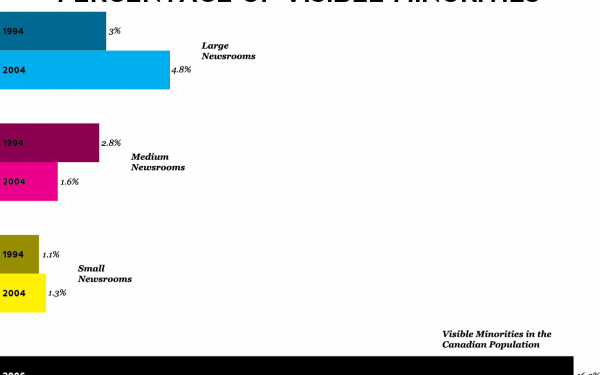Decoding Body Images
What Industry Insiders Have to Say About the Portrayal of Bodies in Fashion
All Media Democracy content is available on our Special Issue Microsite. Works best on Chrome or Firefox.
Fashion, music and advertising industries in modern media have long been criticized for marketing body images, from “thinspiration” to “sexploitation.” The most daring of them use shocking, erotic and pornographic images of teenagers and young women for profit, pitching these images as “artistic.”
But how much is too much? And can the “artsiness” of such ads justify the degrading way its models are portrayed?
Highly sexualized content often drives an increase in sales and profit for leading brands, such as the bold and scandalous clothing company American Apparel, which was founded by Montreal native Dov Charney.
The same goes for products of the music industry, from Miley Cyrus’s controversial music video “Wrecking Ball” to Rihanna’s latest music video “Pour It Up,” which features strippers and Rihanna herself in the littlest amount of clothing possible twerking with spread legs on a throne.
Rihanna also bares it all for her latest British GQ cover, channeling Medusa wearing nothing but snakes. While these kind of marketing tactics create a buzz, they also create uproars.
Toronto-based fashion photographer Bruno Wong thinks that the increasing occurrence and acceptance of sexual and explicit themes and imagery in popular culture have a “huge impact on society.”
“It’s going to change all of our expectations on ourselves and each other,” he said.
“Girls will have it worse because of society’s emphasis on female beauty.”
And girls seem to always have it worse when it comes to American Apparel’s ads.
Their male models are portrayed casually wearing their unisex clothes like an everyday hipster walking through the Plateau.
But the female models are shown wearing clothes with their nipples exposed, not wearing underwear and bearing a lot of unnecessary skin for a simple flannel shirt advertisement. These ads could be considered artsy to some, but it’s predatory and voyeuristic to others.
Sok-Many Chea, co-owner of Montreal-based clothing line Mosaïk, said, she finds the ads “disgusting” and “not attractive at all.”
“I guess they keep doing it because it works for them,” she said.
Wong, who has worked for top modeling agencies in Toronto, Vancouver, New York and Los Angeles, and who also has a background in marketing, sees it a little differently than Chea.
“It’s refreshing to see ‘girl next-door’ types of models over traditional fashion models,” he said.
“I actually prefer it.”
When asked about how he feels about the way American Apparel portrays young women and teenagers as sex objects in their ads, showcasing them half-naked at lewd angles and wearing only one item most of the time—like American Apparel’s “assless pantyhose” or high-knee socks— Wong replied, “Not surprised.”
“It’s a bit extreme, but that’s how everything is moving—the extreme of things,” he said.
“Pretty soon, we’ll be seeing nudity in ads and ads will be more online, where there isn’t as much red tape.”
The line between artistic and pornographic gets increasingly thinner as more and more skin is shown off. So, where do we draw the line?
“Tastefulness, not raunchiness,” said Wong. “And if raunchy, then stylish and complementing the overall brand rather than for shock value.”
But nudity in art has been present for centuries, and such pieces are often heralded for their beauty. What outrages and shocks many people in our century is the vulgarization of sex and sexuality using photographs of teenagers and young women, exposing them to the public and the media in derogatory way for shock value and other marketing-related purposes.
“I feel discouraged. It’s not sexual, it’s repulsive,” said Chea, regarding American Apparel’s most provocative ads.“Sex is a beautiful thing. It should not be shown that way.”
Jillian Tracey Zrihen, owner of Tracey Brooke Public Relations, plays devil’s advocate and sees the profitability in American Apparel’s unconventional methods of marketing body images.
“It seems American Apparel ads are mostly after the shock value to grab potential buyer attention and break through the clutter from every other fashion retail chain out there,” said Zrihen, who possesses more than 10 years’ worth of experience in the marketing, PR and fashion industry.
“The ads can be described as sexy, awkward, edgy or just weird, but they have us talking about them. At the end of the day, that is really the primary goal in advertising,” Zrihen continued.
“The ads might not be in a tasteful manner, but they managed to differentiate themselves and create a consistent image that targets a specific demographic.”
American Apparel, without a doubt, is doing a good job at differentiating their brand, and they’ve gained a niche and brand loyalists. As much as the general public, and even the people within the fashion industry, disapprove of American Apparel and other clothing companies that use sexploitation to increase sales, the reality is that these brands are in demand.
Consumers support them either because they really like to wear their products or because they want to be associated to the brand personality, image and character of these clothing companies—bold, different, sexual, young and naturally beautiful. Many times consumers do not see the inherent unfairness in portraying young women on display this way.
As long as sex is in demand, marketing explicit imagery of human bodies in the fashion industry will not go away unless a restrictive policy is imposed, like in a more conservative country such as Saudi Arabia.
But that wouldn’t fly in North America—after all, this is the land of freedom of expression, and equality. The only problem is that fashion, music and advertising industries sometimes abuse that freedom simply to boost profits.
As for the line between artistic and pornographic, it seems American Apparel agrees with Marshall McLuhan, the Canadian philosopher of communication theory who once said, “Art is anything you can get away with.”
Such “art” includes the photo of young Asian model Kyung, who is wearing an American Apparel Lamé Suspender Swimsuit with her bare breast exposed in the air, and an innocent and girlish expression on her face.
At the end of the day, the “artsiness” of her photograph still does not change the fact that Kyung is still just a girl, someone’s daughter, whose breasts were exposed for profit, selling not only the silver swimsuit she is wearing but as well as her body image and innocence.
We can go on and on about the pornification of our society, and what is wrong with exploiting young women like Kyung in these industries and how marketing their explicit materials as artsy does not justify the content, but despite what society says, the fact remains: sex sells. It’s an easy lowest common denominator.


_600_832_s.png)


JillianPage_600_375_90_s_c1.jpg)
ED1(WEB)_1_600_375_90_s_c1.jpg)
